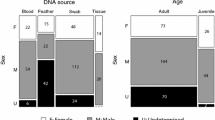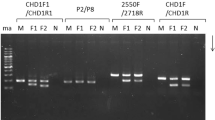Abstract
To aid in avian sex determination if birds are not sexually dimorphic and/or they are sexually immature, several molecular assays involving the polymerase chain reaction (PCR) have been developed. To test in a variety of domestic and wild avian species applicability of five sexing assays: previously described four assays based on nucleotide sequence differences between the Z and W copy of the chicken chromodomain-helicase-DNA-binding protein gene (CHD1Z and CHD1W), and a new sexing marker using the ubiquitin associated protein 2 (UBAP2) gene sequence. At least one molecular sexing marker was successful in 84 out of 88 examined species across 13 avian orders. These assays may be useful in breeding management of domestic and wild birds as well as in studies of avian ecology, population genetics, embryology and transgenesis.





Similar content being viewed by others
REFERENCES
Millar, C.D., Lambert, D.M., Anderson, S. and Halverson, J.L., Molecular sexing of the communally breeding pukeko: an important ecological tool, Mol. Ecol., 1996, vol. 5, no. 2, pp. 289—293. https://onlinelibrary.wiley.com/doi/10.1046/j.1365-294X.1996.00076.x.
Ellegren, H. and Fridolfsson, A.K., Male-driven evolution of DNA sequences in birds, Nat. Genet., 1997, vol. 17, no. 2, pp. 182—184. https://doi.org/10.1038/ng1097-182.
Lessells, K., More mutations in males, Nature, 1997, vol. 390, no. 6657, pp. 236—237. https://doi.org/10.1038/36745.
Kahn, N.W. and Quinn, T.W., Male-driven evolution among Eoaves? A test of the replicative division hypothesis in a heterogametic female (ZW) system, J. Mol. Evol., 1999, vol. 49, no. 6, pp. 750—759. https://doi.org/10.1007/PL00006597.
Robertson, B.C., Millar, C.D., Minot, E.O., et al., Sexing the critically endangered kakapo Strigops habroptilus, Emu, 2000, vol. 100, no. 4, pp. 336—339. https://doi.org/10.1071/MU00056.
Bermudez-Humaran, L.G., Garcia-Garcia, A., Leal-Garza, C.H., et al., Molecular sexing of monomorphic endangered Ara birds, J. Exp. Zool., 2002, vol. 292, no. 7, pp. 677—680. https://doi.org/10.1002/jez.10070.
Romanov, M.N. and Bondarenko, Y.V., Use of autosexing in waterfowl breeding and production, in Proceedings of 10th European Symposium on Waterfowl, Halle, 1995, pp. 473—476.
Wang, N. and Shoffner, R.N., Trypsin G- and C-banding for interchange analysis and sex identification in the chicken, Chromosoma, 1974, vol. 47, no. 1, pp. 61—69. https://doi.org/10.1007/BF00326271.
Nakamura, D., Tiersch, T.R., Douglass, M. and Chandler, R.W., Rapid identification of sex in birds by flow cytometry, Cytogenet. Cell Genet., 1990, vol. 53, no. 4, pp. 201—205. https://doi.org/10.1159/000132930.
De Vita, R., Cavallo, D., Eleuteri, P. and Dell’Omo, G., Evaluation of interspecific DNA content variations and sex identification in Falconiformes and Strigiformes by flow cytometric analysis, Cytometry, 1994, vol. 16, no. 4, pp. 346—350. https://doi.org/10.1002/cyto.990160409.
Kagami, H., Nakamura, H. and Tomita, T., Sex identification in chickens by means of the presence of the W chromosome specific repetitive DNA units, Jpn. Poult. Sci., 1990, vol. 27, no. 5, pp. 379—384. https://doi.org/10.2141/jpsa.27.379.
Cassar, G., Mohammed, M., John, T.M., et al., Differentiating between parthenogenetic and “positive development” embryos in turkeys by molecular sexing, Poult. Sci., 1998, vol. 77, no. 10, pp. 1463—1468. https://doi.org/10.1093/ps/77.10.1463.
D’Costa, S. and Petitte, J.N., Sex identification of turkey embryos using a multiplex polymerase chain reaction, Poult. Sci., 1998, vol. 77, no. 5, pp. 718—721. https://doi.org/10.1093/ps/77.5.718.
Trefil, P., Bruno, M.M., Mikus, T. and Thoraval, P., Sexing of chicken feather follicle, blastodermal and blood cells, Folia Biol. (Praha), 1999, vol. 45, no. 6, pp. 253—256.
Ogawa, A., Solovei, I., Hutchison, N., et al., Molecular characterization and cytological map** of a non-repetitive DNA sequence region from the W chromosome of chicken and its use as a universal probe for sexing Carinatae birds, Chromosome Res., 1997, vol. 5, no. 2, pp. 93—101. https://doi.org/10.1023/A:1018461906913.
Ellegren, H., First gene on the avian W chromosome (CHD) provides a tag for universal sexing of non-ratite birds, Proc. R. Soc. Lond. B Biol. Sci., 1996, vol. 263, no. 1377, pp. 1635—1641. https://doi.org/10.1098/rspb.1996.0239.
Griffiths, R., Daan, S. and Dijkstra, C., Sex identification in birds using two CHD genes, Proc. R. Soc. Lond. B Biol. Sci., 1996, vol. 263, no. 1374, pp. 1251—1256. https://doi.org/10.1098/rspb.1996.0184.
Griffiths, R. and Korn, R.M., A CHD1 gene is Z chromosome linked in the chicken Gallus domesticus, Gene, 1997, vol. 197, nos. 1—2, pp. 225—229. https://doi.org/10.1016/S0378-1119(97)00266-7.
Griffiths, R. and Tiwari, B., Sex of the last wild Spix’s macaw, Nature, 1995, vol. 375, no. 6531, p. 454. https://doi.org/10.1038/375454a0.
Griffiths, R., Double, M.C., Orr, K. and Dawson, R.J., A DNA test to sex most birds, Mol. Ecol., 1998, vol. 7, no. 8, pp. 1071—1075. https://doi.org/10.1046/j.1365-294x.1998.00389.x.
Kahn, N.W., St John, J. and Quinn, T.W., Chromosome-specific intron size differences in the avian CHD gene provide an efficient method for sex identification in birds, Auk, 1998, vol. 115, no. 4, pp. 1074—1078. https://doi.org/10.2307/4089527.
Fridolfsson, A.K. and Ellegren, H., A simple and universal method for molecular sexing of non-ratite birds, J. Avian Biol., 1999, vol. 30, no. 1, pp. 116—121. https://doi.org/10.2307/3677252.
Kerje, S., Sharma, P., Gunnarsson, U., et al., The Dominant white, Dun and Smoky color variants in chicken are associated with insertion/deletion polymorphisms in the PMEL17 gene, Genetics, 2004, vol. 168, no. 3, pp. 1507—1518. https://doi.org/10.1534/genetics.104.027995.
Crittenden, L.B., Provencher, L., Santangelo, L., et al., Characterization of a Red Jungle Fowl by White Leghorn backcross reference population for molecular map** of the chicken genome, Poultry Sci., 1993, vol. 72, no. 2, pp. 334—348. https://doi.org/10.3382/ps.0720334.
Seutin, G., White, B.N. and Boag, P.T., Preservation of avian blood and tissue samples for DNA analyses, Can. J. Zool., 1991, vol. 69, no. 1, pp. 82—90. https://doi.org/10.1139/z91-013.
Lee, M.K., Ren, C.W., Yan, B., et al., Construction and characterization of three BAC libraries for analysis of the chicken genome, Anim. Genet., 2003, vol. 34, no. 2, pp. 151—152. https://doi.org/10.1046/j.1365-2052.2003.00965_5.x.
https://web.archive.org/web/20100709231600/http://hbz7.tamu.edu/homelinks/tool/bac_content.htm.
Madden, T.L., Tatusov, R.L. and Zhang, J., Applications of network BLAST server, Methods Enzymol., 1996, vol. 266, pp. 131—141.
Higgins, D.G. and Sharp, P.M., Fast and sensitive multiple sequence alignments on a microcomputer, Comput. Appl. Biosci., 1989, vol. 5, no. 2, pp. 151—153. https://doi.org/10.1093/bioinformatics/5.2.151.
Thompson, J.D., Higgins, D.G. and Gibson, T.J., CLUSTAL W: improving the sensitivity of progressive multiple sequence alignment through sequence weighting, position-specific gap penalties and weight matrix choice, Nucleic Acids Res., 1994, vol. 22, no. 22, pp. 4673—4680. https://doi.org/10.1093/nar/22.22.4673.
Lombard, V., Camon, E.B., Parkinson, H.E., et al., EMBL-Align: a new public nucleotide and amino acid multiple sequence alignment database, Bioinformatics, 2002, vol. 18, no. 5, pp. 763—764. https://doi.org/10.1093/bioinformatics/18.5.763.
Axelsson, E., Smith, N.G.C., Sundström, H., et al., Male-biased mutation rate and divergence in autosomal, Z-linked and W-linked introns of chicken and turkey, Mol. Biol. Evol., 2004, vol. 21, no. 8, pp. 1538—1547. https://doi.org/10.1093/molbev/msh157.
Lawson Handley, L.J., Ceplitis, H. and Ellegren, H., Evolutionary strata on the chicken Z chromosome: implications for sex chromosome evolution, Genetics, 2004, vol. 167, no. 1, pp. 367—376. https://doi.org/10.1534/genetics.167.1.367.
Sazanov, A.A., Sazanova, A.L., Stekolnikova, V.A., et al., Chromosomal localization of the UBAP2Z and UBAP2W genes in chicken, Anim. Genet., 2006, vol. 37, no. 1, pp. 72—73. https://doi.org/10.1111/j.1365-2052.2005.01392.x.
Albrecht, D.J., Sex ratio manipulation within broods of house wrens, Troglodytes aedon, Anim. Behav., 2000, vol. 59, no. 6, pp. 1227—1234. https://doi.org/10.1006/anbe.1999.1420.
Romanov, M.N., Kutnyuk, P.I. and Chernikov, V.F., Estimation of population structure and differentiation in black-headed gull by using genetic/oological parameters: 1. Analysis within an East-Ukrainian population, J. Ornithol., 1994, vol. 135, no. 1, p. 261. https://doi.org/10.1007/BF02445773.
Romanov, M.N. and Dodgson, J.B., Cross-species overgo hybridization and comparative physical map** within avian genomes, Anim. Genet., 2006, vol. 37, no. 4, pp. 397—399. https://doi.org/10.1111/j.1365-2052.2006.01463.x.
Romanov, M.N., Koriabine, M., Nefedov, M., et al., Construction of a California condor BAC library and first-generation chicken—condor comparative physical map as an endangered species conservation genomics resource, Genomics, 2006, vol. 88, no. 6, pp. 711—718. https://doi.org/10.1016/j.ygeno.2006.06.005.
Romanov, M.N., Tuttle, E.M., Houck, M.L., et al., The value of avian genomics to the conservation of wildlife, BMC Genomics, 2009, vol. 10, suppl. 2, p. S10. https://doi.org/10.1186/1471-2164-10-S2-S10.
Romanov, M.N., Dodgson, J.B., Gonser, R.A. and Tuttle, E.M., Comparative BAC-based map** in the white-throated sparrow, a novel behavioral model, using interspecies overgo hybridization, BMC Res. Notes, 2011, vol. 4, p. 211. https://doi.org/10.1186/1756-0500-4-211.
Narushin, V.G., Romanov, M.N. and Bogatyr, V.P., Method for preincubational prediction of embryo sex in chicken eggs, in Proceedings of the 8th World Conference on Animal Production, Seoul, 1998, vol. 1, pp. 832—833.
ACKNOWLEDGMENTS
The work was supported by grants from the United States Department of Agriculture/Cooperative State Research, Education, and Extension Service (99-35205-8566 and 2001-52100-11225) to J.B. Dodgson, and from the National Institutes of Health (R01GM084229) to E.M. Tuttle and R.A. Gonser. We are most grateful to Hans Ellegren (Uppsala University, Uppsala, Sweden) and Nate Kahn (University of Denver, Denver, CO, USA) for sharing aliquots of the sexing primers, 2550F/2718R and 1237L/1272H, respectively. We also thank Hans Ellegren for providing us with the UBAP2 sequence information, and Hans Cheng (USDA-ARS Avian Disease and Oncology Laboratory, East Lansing, MI, USA) for sequencing the common quail CHD1 fragments. Natalie Dubois (Michigan State University, East Lansing, MI, USA) is acknowledged for sharing the House Wren DNA samples, and Tanya Romanov (Michigan State University, East Lansing, MI, USA) and Sarah Ford (Indiana State University, Terre Haute, IN, USA) for technical assistance. We thank Olga Krestinina (Zelenodolsk, Russia) for graphical work.
Author information
Authors and Affiliations
Corresponding author
Ethics declarations
Conflict of interests. The authors declare that they have no conflict of interest.
Statement on the welfare of animals. All applicable international, national, and/or institutional guidelines for the care and use of animals were followed.
Additional information
The article is published in the original.
Rights and permissions
About this article
Cite this article
Romanov, M.N., Betuel, A.M., Chemnick, L.G. et al. Widely Applicable PCR Markers for Sex Identification in Birds. Russ J Genet 55, 220–231 (2019). https://doi.org/10.1134/S1022795419020121
Received:
Revised:
Accepted:
Published:
Issue Date:
DOI: https://doi.org/10.1134/S1022795419020121




